Youngmin Baek
CREPE: Coordinate-Aware End-to-End Document Parser
May 01, 2024



Abstract:In this study, we formulate an OCR-free sequence generation model for visual document understanding (VDU). Our model not only parses text from document images but also extracts the spatial coordinates of the text based on the multi-head architecture. Named as Coordinate-aware End-to-end Document Parser (CREPE), our method uniquely integrates these capabilities by introducing a special token for OCR text, and token-triggered coordinate decoding. We also proposed a weakly-supervised framework for cost-efficient training, requiring only parsing annotations without high-cost coordinate annotations. Our experimental evaluations demonstrate CREPE's state-of-the-art performances on document parsing tasks. Beyond that, CREPE's adaptability is further highlighted by its successful usage in other document understanding tasks such as layout analysis, document visual question answering, and so one. CREPE's abilities including OCR and semantic parsing not only mitigate error propagation issues in existing OCR-dependent methods, it also significantly enhance the functionality of sequence generation models, ushering in a new era for document understanding studies.
TRACE: Table Reconstruction Aligned to Corner and Edges
May 01, 2023Abstract:A table is an object that captures structured and informative content within a document, and recognizing a table in an image is challenging due to the complexity and variety of table layouts. Many previous works typically adopt a two-stage approach; (1) Table detection(TD) localizes the table region in an image and (2) Table Structure Recognition(TSR) identifies row- and column-wise adjacency relations between the cells. The use of a two-stage approach often entails the consequences of error propagation between the modules and raises training and inference inefficiency. In this work, we analyze the natural characteristics of a table, where a table is composed of cells and each cell is made up of borders consisting of edges. We propose a novel method to reconstruct the table in a bottom-up manner. Through a simple process, the proposed method separates cell boundaries from low-level features, such as corners and edges, and localizes table positions by combining the cells. A simple design makes the model easier to train and requires less computation than previous two-stage methods. We achieve state-of-the-art performance on the ICDAR2013 table competition benchmark and Wired Table in the Wild(WTW) dataset.
DEER: Detection-agnostic End-to-End Recognizer for Scene Text Spotting
Mar 10, 2022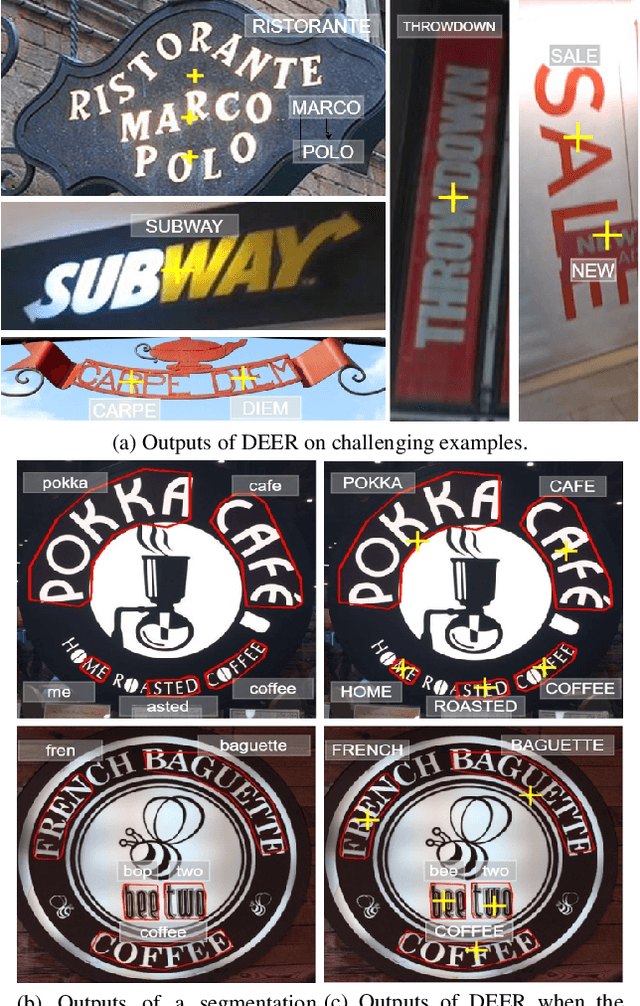
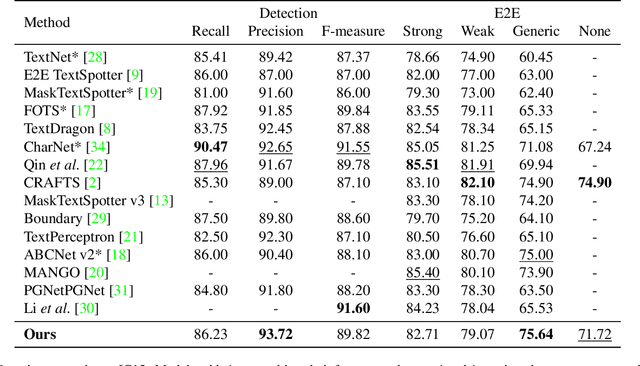
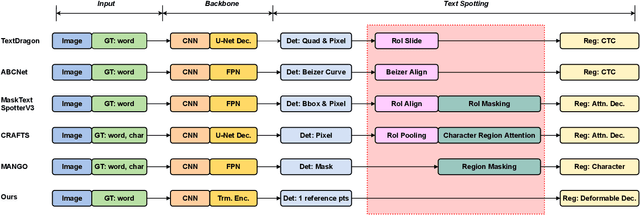
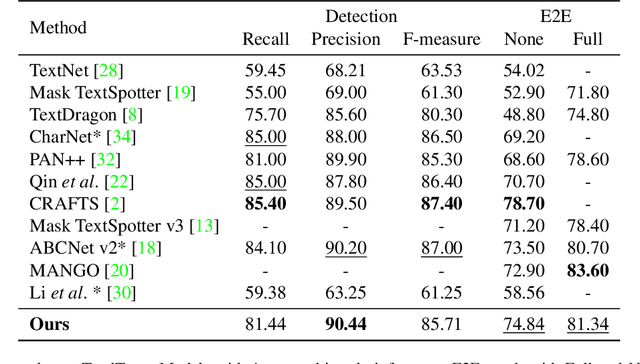
Abstract:Recent end-to-end scene text spotters have achieved great improvement in recognizing arbitrary-shaped text instances. Common approaches for text spotting use region of interest pooling or segmentation masks to restrict features to single text instances. However, this makes it hard for the recognizer to decode correct sequences when the detection is not accurate i.e. one or more characters are cropped out. Considering that it is hard to accurately decide word boundaries with only the detector, we propose a novel Detection-agnostic End-to-End Recognizer, DEER, framework. The proposed method reduces the tight dependency between detection and recognition modules by bridging them with a single reference point for each text instance, instead of using detected regions. The proposed method allows the decoder to recognize the texts that are indicated by the reference point, with features from the whole image. Since only a single point is required to recognize the text, the proposed method enables text spotting without an arbitrarily-shaped detector or bounding polygon annotations. Experimental results present that the proposed method achieves competitive results on regular and arbitrarily-shaped text spotting benchmarks. Further analysis shows that DEER is robust to the detection errors. The code and dataset will be publicly available.
Character Region Attention For Text Spotting
Jul 19, 2020

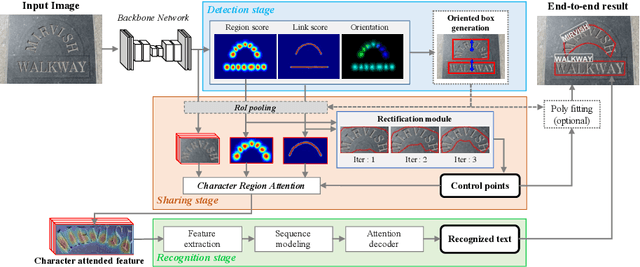
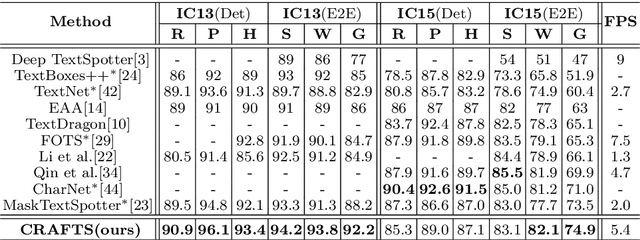
Abstract:A scene text spotter is composed of text detection and recognition modules. Many studies have been conducted to unify these modules into an end-to-end trainable model to achieve better performance. A typical architecture places detection and recognition modules into separate branches, and a RoI pooling is commonly used to let the branches share a visual feature. However, there still exists a chance of establishing a more complimentary connection between the modules when adopting recognizer that uses attention-based decoder and detector that represents spatial information of the character regions. This is possible since the two modules share a common sub-task which is to find the location of the character regions. Based on the insight, we construct a tightly coupled single pipeline model. This architecture is formed by utilizing detection outputs in the recognizer and propagating the recognition loss through the detection stage. The use of character score map helps the recognizer attend better to the character center points, and the recognition loss propagation to the detector module enhances the localization of the character regions. Also, a strengthened sharing stage allows feature rectification and boundary localization of arbitrary-shaped text regions. Extensive experiments demonstrate state-of-the-art performance in publicly available straight and curved benchmark dataset.
CLEval: Character-Level Evaluation for Text Detection and Recognition Tasks
Jun 11, 2020



Abstract:Despite the recent success of text detection and recognition methods, existing evaluation metrics fail to provide a fair and reliable comparison among those methods. In addition, there exists no end-to-end evaluation metric that takes characteristics of OCR tasks into account. Previous end-to-end metric contains cascaded errors from the binary scoring process applied in both detection and recognition tasks. Ignoring partially correct results raises a gap between quantitative and qualitative analysis, and prevents fine-grained assessment. Based on the fact that character is a key element of text, we hereby propose a Character-Level Evaluation metric (CLEval). In CLEval, the \textit{instance matching} process handles split and merge detection cases, and the \textit{scoring process} conducts character-level evaluation. By aggregating character-level scores, the CLEval metric provides a fine-grained evaluation of end-to-end results composed of the detection and recognition as well as individual evaluations for each module from the end-performance perspective. We believe that our metrics can play a key role in developing and analyzing state-of-the-art text detection and recognition methods. The evaluation code is publicly available at https://github.com/clovaai/CLEval.
TedEval: A Fair Evaluation Metric for Scene Text Detectors
Jul 02, 2019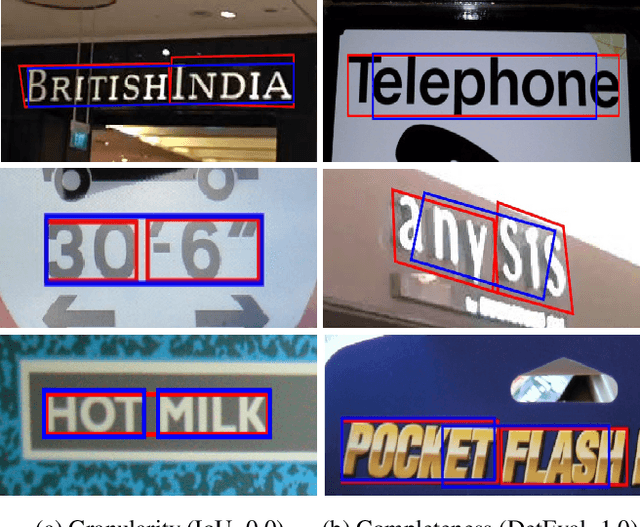
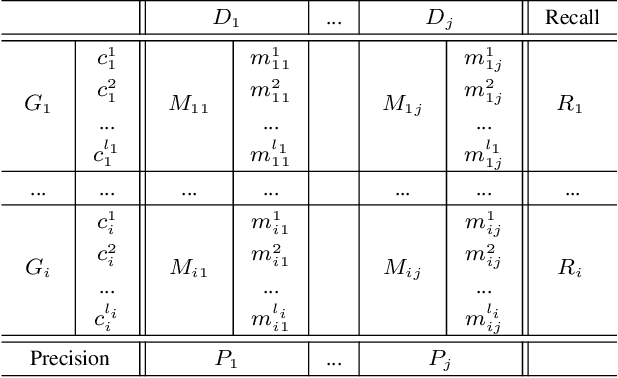
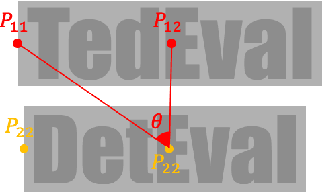

Abstract:Despite the recent success of scene text detection methods, common evaluation metrics fail to provide a fair and reliable comparison among detectors. They have obvious drawbacks in reflecting the inherent characteristic of text detection tasks, unable to address issues such as granularity, multiline, and character incompleteness. In this paper, we propose a novel evaluation protocol called TedEval (Text detector Evaluation), which evaluates text detections by an instance-level matching and a character-level scoring. Based on a firm standard rewarding behaviors that result in successful recognition, TedEval can act as a reliable standard for comparing and quantizing the detection quality throughout all difficulty levels. In this regard, we believe that TedEval can play a key role in developing state-of-the-art scene text detectors. The code is publicly available at https://github.com/clovaai/TedEval.
Character Region Awareness for Text Detection
Apr 03, 2019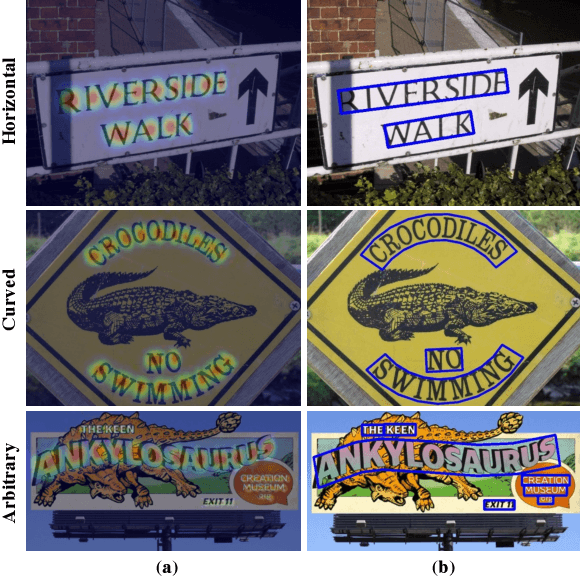
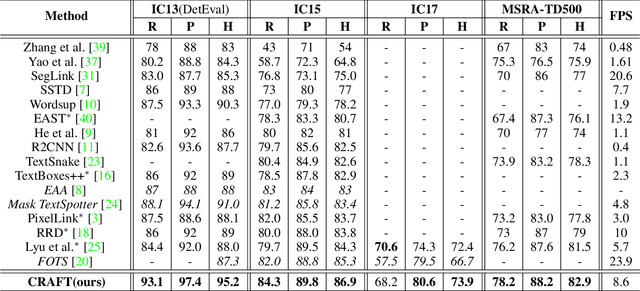
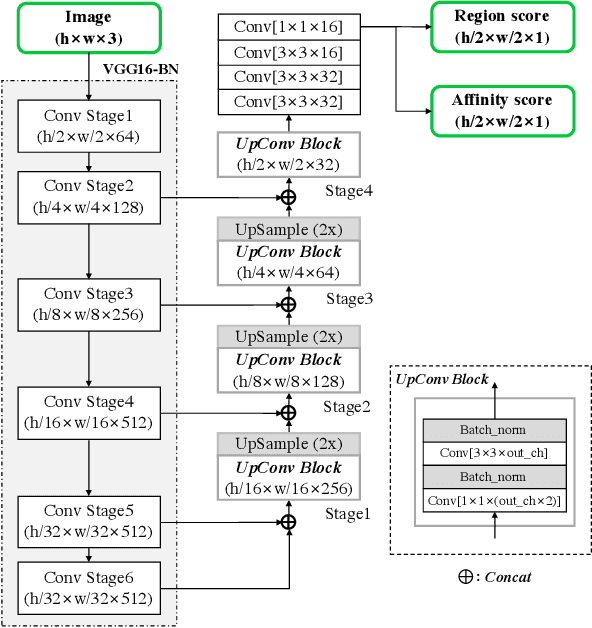
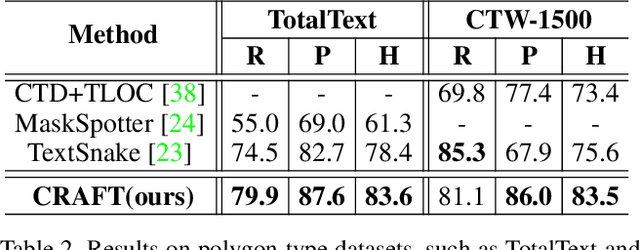
Abstract:Scene text detection methods based on neural networks have emerged recently and have shown promising results. Previous methods trained with rigid word-level bounding boxes exhibit limitations in representing the text region in an arbitrary shape. In this paper, we propose a new scene text detection method to effectively detect text area by exploring each character and affinity between characters. To overcome the lack of individual character level annotations, our proposed framework exploits both the given character-level annotations for synthetic images and the estimated character-level ground-truths for real images acquired by the learned interim model. In order to estimate affinity between characters, the network is trained with the newly proposed representation for affinity. Extensive experiments on six benchmarks, including the TotalText and CTW-1500 datasets which contain highly curved texts in natural images, demonstrate that our character-level text detection significantly outperforms the state-of-the-art detectors. According to the results, our proposed method guarantees high flexibility in detecting complicated scene text images, such as arbitrarily-oriented, curved, or deformed texts.
 Add to Chrome
Add to Chrome Add to Firefox
Add to Firefox Add to Edge
Add to Edge